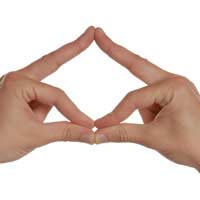Finger Spelling

Finger spelling is a method of communicating with the hands which is closely linked to sign language. However unlike sign language, it is not a language in its own right and does not have grammatical structures and syntaxes. Rather, it is a way of spelling out words instead of interpreting them as a gesture. This means that anyone who knows the finger spelling alphabet can communicate – however, it can be a lengthy process as every letter has to be spelt and is therefore not widely used for general conversations.
In Sign Language
Finger spelling is often used alongside sign language for one of two reasons. It may be that a name or other such word needs spelling out, and therefore finger spelling is the only way to do this. Place names and people’s names do not generally have a sign of their own and thus they need to be finger spelt. But finger spelling is also a way of giving greater clarity or emphasis to something. Sing language can be very expressive and using finger spelling is one way which ‘speakers’ of sign language can be more emotional.How Finger Spelling Works
Finger spelling can be used in two main ways. The first is the simple act of tracing the shape of the letter in the air. This is very basic and takes more time and concentration than the other way. It is not usually used by people who are fluent in sign language. The second, more usual, way of finger spelling is to use symbols on the hand for each letter. But, as with the sign languages throughout the world, the same symbols are not used in different languages and thus different language’s 'Sign Languages' could have different finger spelling symbols. The symbols are essentially, stylised examples of the letter’s shape, but cut down for simplicity’s sake.Speed and Clarity
The way which finger spelling is used in a sign language system can vary massively between countries and language systems. In British Sign Language, finger spelling is used with deliberate movements and slowly and clearly. But in other languages, for example, Italian Sign Language, finger spelling is used at high speeds. The differences between countries can be very wide, such as this, and also, closer to others – much like accents in spoken languages.Finger spelling is a very useful tool and a great way to start learning sign language. It is relatively easy to pick up because there are just 26 signs to learn, plus another ten for figures. But it means that although you will not be able to understand sign language users, they can understand you. And if there is something they need to tell you, they can at least spell it out.
The more practice you do, the quicker you will become. And finger spelling is a great introduction to signing and will help you in the future should you wish to learn the full sign language system. It is a great way of getting by in sign language, and will give a good foundation for a wider knowledge and level of fluency of the full language system.
- Sign Language Vs Pidgin - Which is Most Complex?
- The Relationship Between Sign Language and Mime
- Can Baby Signing Really Help My Child's Development?
- Signing About the Weather
- Transport and Holidays
- Personal Information
- Sports and Hobbies
- Time, Date and Days of the Week
- Around the Home
- Everyday Tasks
- Getting to Know One Another
- Greetings and Introductions


Re: The Listening Bus
Hi, We would like to book the listening bus for our school community. What is your availability for the summer term 2025? What are the costs? We…
Re: Sign Supported English
Ex Mary hare school. Love sign supported English as Aspie. More useful Less emotional As words Not emotion More helpful to deaf Aspies
Re: The Listening Bus
Hi, I am the inclusion leader and SENCo of a school with a specialist resource provision for deaf pupils within a mainstream school. Staff say…
Re: The British Sign Language Broadcasting Trust
I’m not effected in any way or suffer from any communication issues personally. I was curious as to why…
Re: Sign Supported English
I want a series of videos to learn SIGN SUPPORTED ENGLISH FOR BEGINNERS. Can you please help?
Re: Makaton
Hello We are a small pre-school and we are trying to teach all our children Makaton to help all of them communicate regardless of their own…
Re: Sign Supported English
Can anyone help me ? I am trying to find an SSE class or lessons in Kent and have had no luck. Failing that, are there any publications I…
Re: Hands on Signing
Hi I have a blind child and he has a moderate hearing loss. I wonder if you can help me to teach him sign language and I need to learn as well.…
Re: Sign Supported English
Does anyone know of any programmes or resources for using SSE with older people whose hearing has deteriorated in later life?
Re: Makaton
what is makaton??????????????????????????